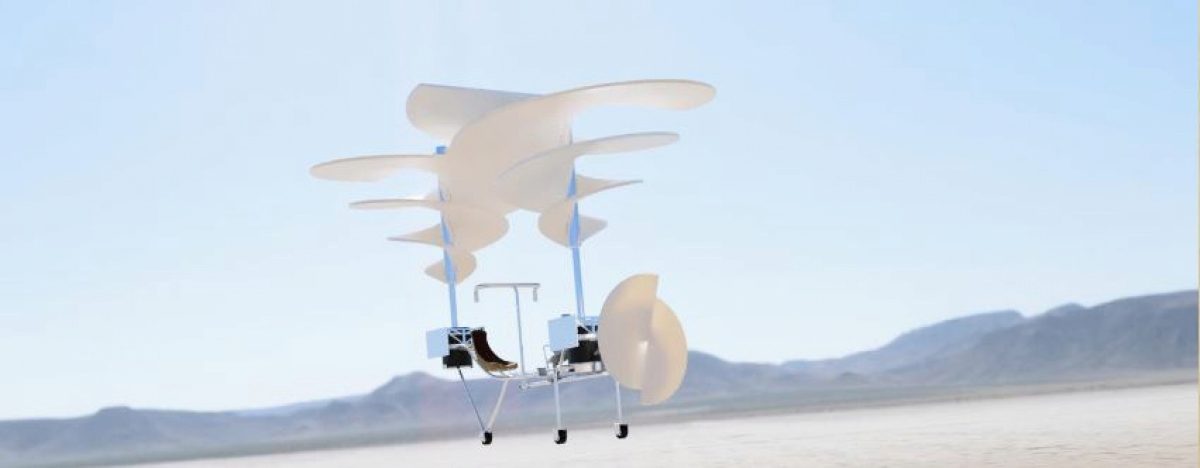
Reviving a Classic. The Il Mulinello vehicle, depicted above, revived da Vinci's Aerial Screw ...and brought a top honor for Georgia Tech graduate students in the Vertical Flight Society's 37th Annual Student Design Competition, which fielded submissions from around the world.
 |
|
Alex Moushegian |
Il Mulinello, a vertical take-off and landing (VTOL) vehicle designed by graduate students from the Daniel Guggenheim School of Aerospace Engineering, has taken second place in the graduate division of the Vertical Flight Society's 37th Annual Student Design Competition.
The VFS competition annually fields submissions from student teams across the globe to design a VTOL aircraft that meets specified requirements. The competition provides a practical exercise for college-level engineering students to promote student interest in VTOL engineering and technology.
The theme of this year's competition, “Leonardo’s Aerial Screw: 500 Years Later,” celebrated the precocious genius of da Vinci, whose famous drawing of the Aerial Screw has been recognized by many as the first human-carrying VTOL machine ever designed. It took more than 400 years for mankind to develop the concept into what we now know as the modern helicopter.
"Working in the 1400's, da Vinci was basing his idea on Archimedes' screw, which was a water pump," said team lead, AE doctoral student Alex Moushegian.
"Da Vinci didn't have the knowledge of fluid mechanics that we have now, so it didn't work as he had envisioned," Moushegian explained. "With air, when you have such a large surface, you need more energy to overcome the friction, the drag. Modern-day, conventional rotor blades induce a circular air flow from the very top, which reduces the drag."
 |
| The Inspiration for Il Mulinello |
The goal of this year’s VFS competition, sponsored by Leonardo Helicopters, was to design a VTOL vehicle based on Leonardo’s Aerial Screw concept, studying and demonstrating the consistency of its physics and potential feasibility. The actual pros and cons of the Aerial Screw are often quoted but have not been analyzed extensively, nor has a possible working application been studied, leaving a gap in the technical understanding of the significance of the invention. The competition completed a critical review of each team's Leonardo Aerial Screw approach to understand how the concept can be considered the foundation of vertical flight.
Moushegian said he and his teammates, fellow grad students Carlota Bonnet, Alex Markov and Milad Mozayyani, worked tirelessly during the COVID-19 shutdown to finesse three models that would serve as the basis for their design: a helix with no taper, a helix with a taper, and a helix with a larger pitch ratio.
 |
| Il Mulinello's Take on Classic Design |
"When COVID shut down the campus, we had to cancel our real-world experiment to test various airscrew geometries," said Moushegian. "We relied on a computational fluid dynamics analysis of the different geometries of our final airscrew design. In the end, we were confident of the full vehicle design we were able to submit."
As the #2 team in the graduate student category, Il Mulinello ("the whirlwind") took home $1,800 in prize money and an invitation to attend the VFS Forum in 2021. Moushegian doesn't yet know if that will be virtual or in-person, but he plans to attend.
"I think we did a good job using da Vinci's ideas to make a rotor that would actually work," said Moushegian. "If you follow him [da Vinci] too closely, it wouldn't have worked. But we used modern design analysis to interpret his concepts so they would work. As an engineer, that felt good. You want to see the final model. work."
 |
|
Prof. Dimitri Mavris |
 |
| Prof. Marilyn Smith VLRCOE Director |
Though Team Il Mulinello benefited from a design class, their work on the VFS competition drew mainly on their love of design and their fascination with rotorcraft. They were advised by some of the best: Prof. Marilyn J. Smith, who heads up the Vertical Lift Research Center of Excellence (VLRCOE) and Prof. Dimitri Mavris, the head of the Aerospace Systems Design Lab (ASDL).
Their win is the result of a new joint ASDL-VLRCOE collaboration for vertical lift design. Explains Smith:
“The Il Mulinello is an amazing testament of the GT vertical lift students and experience, as their winning entrant was accomplished with in a single semester and with fewer team members than the other teams who placed in the top three of the competition."
Time to Plan for Next Year
The 2020-2021 request for proposal (RFP) for the 38th Annual Student Design Competition, “2025 UAV for Medical Equipment Distribution" will be made available later this month. The Vertical Flight Society encourages universities from around the world to form teams and take part in this exciting and challenging competition, which is conducted to attract the best and brightest engineering students to the vertical flight industry.
This year, Georgia Tech plans to field teams in the both the graduate and undergraduate categories. Students can participate as part of rotorcraft design courses or by relaying their interest to Smith. Sign-up for Rotorcraft Design for the Fall semester is open until August 21.
The Vertical Flight Society is the world’s premier vertical flight technical society. Since it was founded as the American Helicopter Society in 1943, the Society has been a major force in the advancement of vertical flight. VFS is the global resource for information on vertical flight technology. For more than 75 years, it has provided global leadership for scientific, technical, educational and legislative initiatives that advance the state of the art of vertical flight.